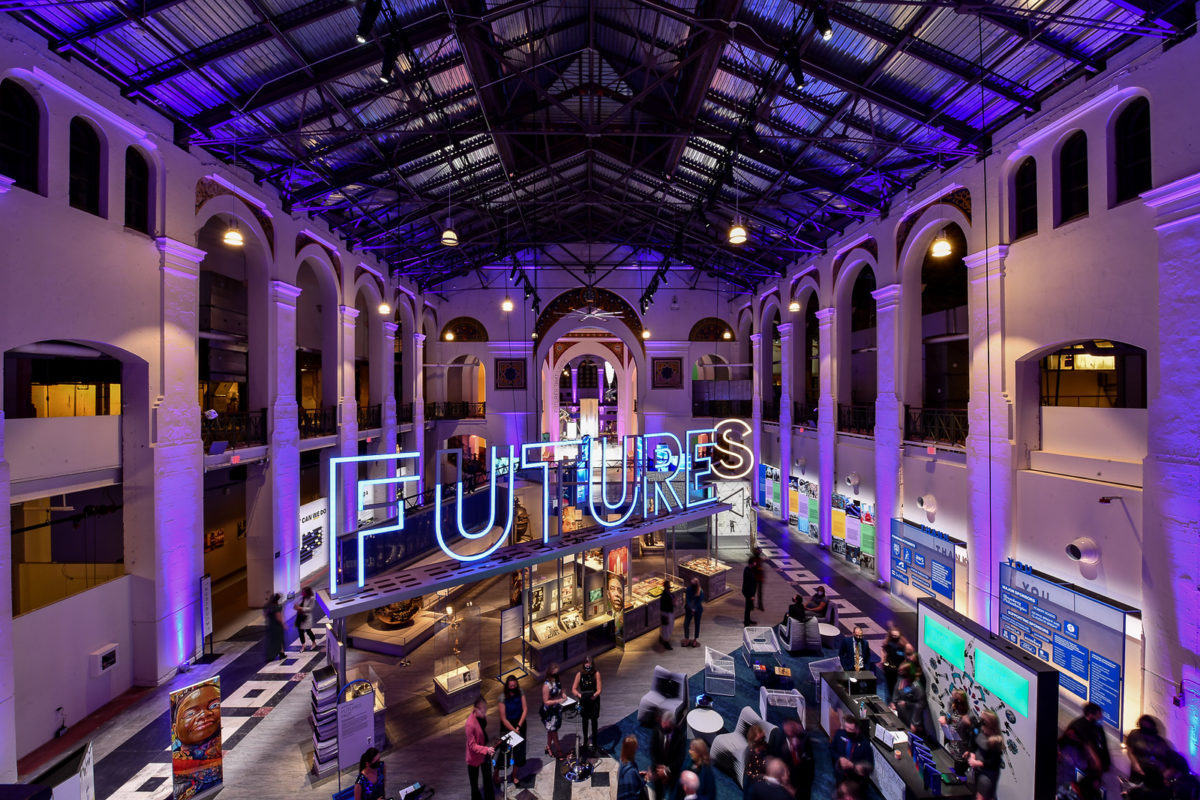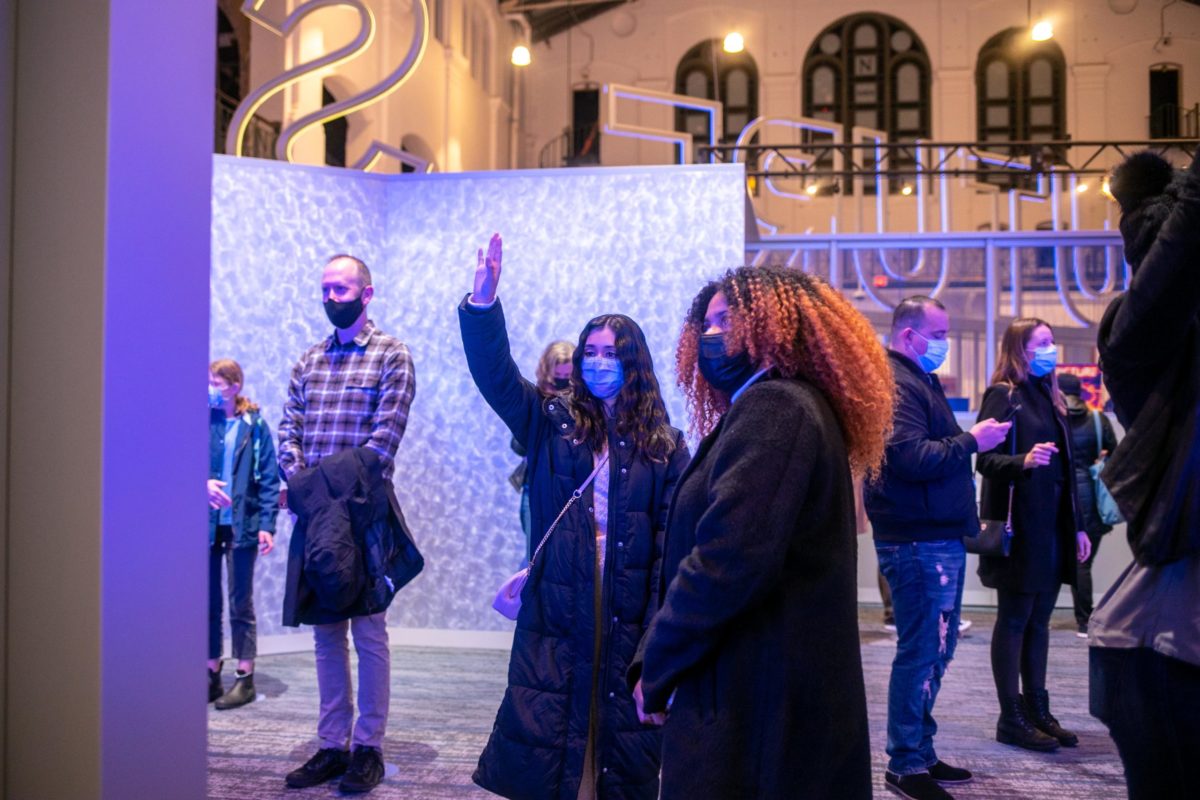With all the crises rocking the world, from the pandemic to extreme climate events, it has become more difficult to view the future through a positive lens, or even peer into it at all without trepidation.
The Smithsonian Arts and Industries Building is intent on mitigating that gloominess, and adding a dose of optimism in the world through its FUTURES exhibition, which opened Nov. 20 and runs through July 2022.
The tech laden exhibition will not harness technology for technology’s sake. Rather, it presents emerging technologies in a “meaningful way,” notes Brad MacDonald, director of creative media for the Arts and Industries Building at the Smithsonian.
The exhibition was designed to “frame a more positive, equitable, and sustainable view of the future,” MacDonald said, adding that it “offers an alternative way of thinking about the future, and engages visitors in new ways about emerging technologies.”
Those technologies run the gamut from “AI to haptics to gestural interfaces,” but also include “traditional interactive forms, such as games,” MacDonald said. He characterizes the entire exhibition as “very experimental.”
“We’re presenting new technologies never seen before,” he said.
The exhibition was developed in conjunction with the Lab at Rockwell Group, a design innovation studio. Nearly 150 objects are featured in the exhibition, including inventions that are making their Smithsonian debut, MacDonald said. These include:
- An artificial intelligence-driven rover from Alphabet’s X lab that could transform agriculture.
- A Planetary Society space sail for deep space travel.
- A Loon internet balloon.
- The first Buckminster Fuller geodesic dome built in North America.
- The world’s first controlled thermonuclear fusion device.
Special attention is devoted in the exhibition to making technology more accessible to disadvantaged groups. For example, one experience is designed to connect people with disabilities to new technologies by enabling them to play Minecraft, MacDonald said.
Another engaging experience, developed in association with Autodesk, allows “three visitors, acting in the roles of mayor, ecologist, and real estate developer, to collaboratively develop an urban neighborhood through generative design. An AI tool offers suggestions to the players in order to help them balance their diverse needs,” MacDonald said.
The exhibition has four touchpoints These include FUTURES beacons, which are 12 beacons allowing visitors to interact with exhibits in that area through a gestural haptic feedback system. Visitors essentially wave their hands over an ultrasonic speaker, giving them more of a surface sensation. Another touchpoint has a hologram, enabling visitors to interact with exhibits and artifacts.
The exhibition will be housed in each of the museum’s four halls, which are titled Past Futures, Futures that Inspire, Futures that Unite, and Futures that Work.
In the “Futures That Unite” environment, visitors can view a COVID-friendly support robot that reduces loneliness, a video game that can be played using the eyes, and biohacked insulin.
The “Futures that Work” environment will allow visitors to “experience future foods, a spacesuit that fits like a second skin, a working water harvester pulling liquid from air, and an algae bioreactor that cleans as much air as a 400-acre forest,” MacDonald said.

An overhead view of the Smithsonian’s FUTURES exhibition. (Courtesy photo)
The exhibition will incorporate a PlayLab that will offer diverse VR and AR experiences with content that rotates on a month basis. In this regard, the museum “is working with Oracle to create a new VR experience,” MacDonald said.
He adds that there will be a “real time factor” to the exhibition, MacDonald said. For example, visitors will have an opportunity to input visions of the future, and have them displayed anonymously. The museum also plans to host workshops, performances and lectures on a rotating basis.
It’s also “developing a new web component that’s fairly experimental, which will fuse a group of experimental technologies and push the boundaries of what online exhibits will look in the future,” though MacDonald isn’t at liberty to provide more details at this time.
With significant market research conducted to inform it, the exhibition is aimed at a broad audience, though it’s particularly targeted at visitors from late teens to 40s. From a broader perspective, the exhibition is geared to visitors “interested in creating effective change,” MacDonald said.
Join the conversation!
Find news, events, jobs and people who share your interests on Technical.ly's open community Slack

DC daily roundup: the DMV's VC cooldown, SmartSigns for safer driving; Rep. Schiff's AI copyright bill

Will the life sciences dethrone software as the king of technology?

Delaware tech leaders gather at White House for action summit with Biden and Harris

